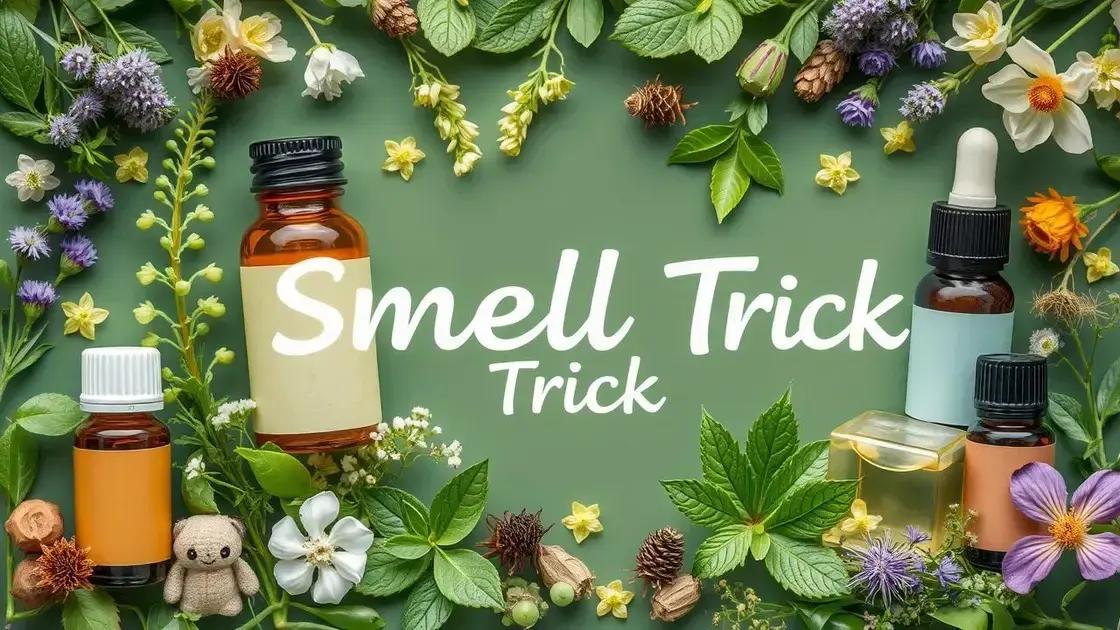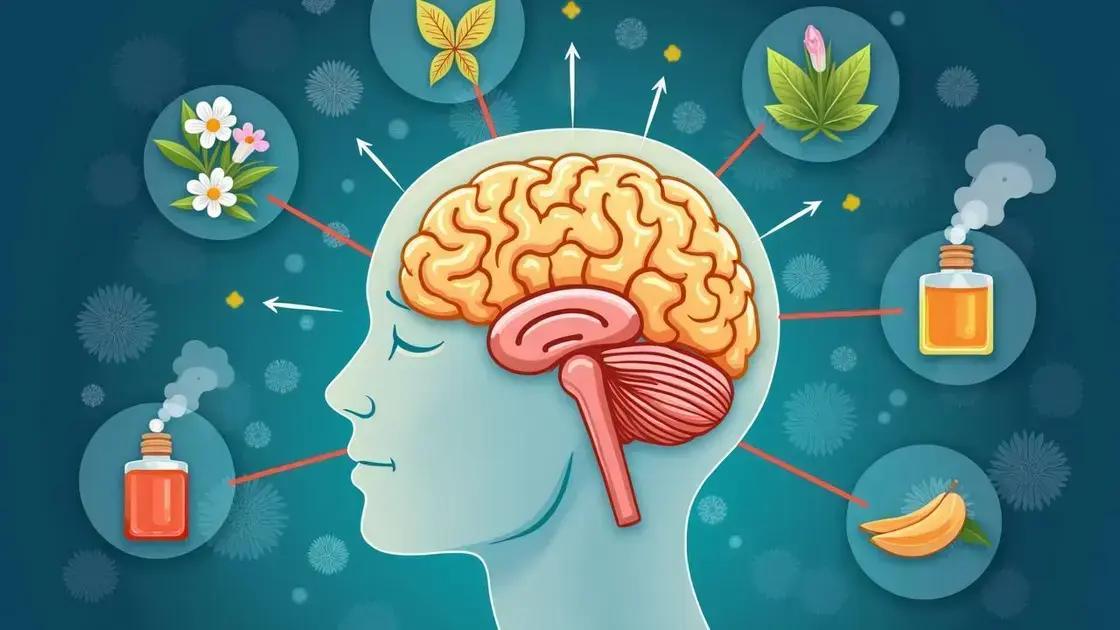The Smell Trick is a healing practice that utilizes specific scents to enhance emotional well-being and support physical health, deeply rooted in traditional healing cultures and supported by scientific research.
The Smell Trick has intrigued many who seek alternative healing methods. As traditional healers become more celebrated, there’s a growing curiosity about their recommendations on unique practices like the Smell Trick. This article delves into how various cultures incorporate scents into healing and the insights traditional healers provide. Is it a mere myth, or do these scents hold genuine healing power? Join us as we explore the layers behind this fascinating practice.
Understanding the Smell Trick

The Smell Trick refers to the use of specific scents as a form of alternative healing. Many people are fascinated by how aromas can influence our emotions and well-being. This phenomenon is often linked to the concept of aromatherapy, which uses essential oils derived from plants.
How It Works
When certain smells are inhaled, they can trigger brain responses. This happens because our sense of smell is closely connected to the limbic system, the part of the brain that handles emotions and memories. For instance, calming scents like lavender can help reduce anxiety, while refreshing smells like citrus can uplift mood.
The Role of Traditional Healers
Traditional healers around the world have long used scents for healing. In cultures that practice herbal medicine, plants are not just ingested but also inhaled to promote healing. Some argue this gives them a unique edge in understanding how scents can impact our health.
Benefits of the Smell Trick
People believe the Smell Trick can help alleviate various conditions, from headaches to stress. It is seen not only as an effective method to heal but also as a way to enhance overall wellness. As more people seek natural remedies, interest in olfactory therapies continues to grow.
Conclusion
Overall, the understanding of the Smell Trick showcases the blend of culture, tradition, and science. As we explore these ancient practices, we may uncover profound insights for modern healing.
Traditional Healers and Their Practices

Traditional healers have a significant role in many communities around the world. They use centuries-old practices to treat physical and mental ailments. Among these practices is the use of various scents and herbs for healing.
Healing Practices in Different Cultures
Various cultures have distinct methods of healing that incorporate the Smell Trick. For instance, in African traditional medicine, healers often utilize essential oils and aromatic herbs. These are believed to cleanse the spirit and promote health.
The Use of Aromatic Herbs
Many traditional healers employ aromatic herbs in their treatments. They prepare teas, poultices, and infusions that are both inhaled and consumed. Common examples include sage, which is thought to purify the environment, and eucalyptus, known for its refreshing properties.
Community and Ritual
The practices of traditional healers are often rooted in community rituals. These may include ceremonies that focus on healing through smell, where specific scents are used to create a calming atmosphere. This helps in connecting individuals to their cultural heritage while fostering a sense of belonging.
Personalization in Treatment
Traditional healers emphasize personalized treatment. They often work one-on-one with their patients, taking into account their unique experiences and needs. This individualized approach may involve the cultivation of trust, allowing the healer to recommend specific scents that resonate with the patient.
Scientific Perspectives on the Smell Trick

The Smell Trick raises many questions from a scientific perspective. Researchers are exploring how various scents can influence human emotions, health, and overall well-being. Understanding this connection sheds light on why traditional healers endorse the practice.
The Biology of Smell
Our sense of smell starts in the nose, where aroma molecules travel to the olfactory bulb in the brain. This part of the brain is closely linked to memory and emotion. When we smell something, it can trigger memories or feelings, which helps explain the effectiveness of the Smell Trick.
Scientific Studies on Aromatherapy
Numerous studies have been conducted to examine the effects of different scents. For instance, research suggests that lavender can reduce anxiety, while peppermint might enhance focus and energy. These findings provide a scientific basis for the practices of traditional healers who rely on these scents.
Psychological Impact
The psychological effects of aromas are well documented. Scents can influence mood, stress levels, and overall mental health. For instance, a pleasant smell can stimulate positive emotions and reduce feelings of depression. This aligns with the idea that the Smell Trick can serve as a supportive tool for emotional healing.
Integration of Traditional and Modern Medicine
The combination of traditional healing practices and scientific research opens new doors for therapies. Some healthcare professionals now incorporate olfactory practices into treatment plans. They recognize the power of scent and how it can complement medical practices, providing a holistic approach to healing.
Cultural Significance of the Smell Trick

The Smell Trick holds deep cultural significance in many societies. It often reflects the values, beliefs, and healing practices of different communities. Across history, specific scents have been tied to rituals, celebrations, and healing traditions.
Role in Rituals and Ceremonies
Many cultures use particular smells during rituals and ceremonies. For example, the burning of incense is common in spiritual practices from Asia to the Americas. These smells are believed to foster a connection with the spiritual world and promote healing.
Connection to Heritage and Identity
Smells often evoke a sense of heritage and identity among community members. In many cultures, the practice of using specific scents in healing ties back to ancestral knowledge. This connection helps individuals feel rooted in their traditions.
Therapeutic Practices in Different Cultures
The Smell Trick is an integral part of therapeutic practices around the world. In Indian Ayurveda, for instance, essential oils are used not only for physical healing but also for emotional balance. Similarly, Native American tribes often incorporate local herbs and plants to enhance well-being.
Fostering Community and Connection
Using scents in healing fosters a sense of community. When people gather for healing ceremonies, they share experiences and stories related to the scents. This communal aspect strengthens bonds among members and creates a support system.
The Role of the Smell Trick in Healing
In summary, the practice of the Smell Trick is deeply rooted in tradition and culture. From the insights of traditional healers to the scientific understanding of how scents affect our emotions and health, it is clear that this method holds significant value.
As we investigate the cultural significance, we see its role in rituals and personal connections within communities, which enhances the overall experience of healing. While scientific studies continue to validate these traditional practices, the uniqueness of the Smell Trick remains evident across various cultures.
Thus, recognizing the Smell Trick not only enriches our understanding of healing but promotes a holistic approach that merges tradition with modern perspectives.
FAQ – Frequently Asked Questions about the Smell Trick
What is the Smell Trick?
The Smell Trick refers to the use of specific scents to promote healing and improve emotional well-being.
How do traditional healers incorporate the Smell Trick?
Traditional healers use various aromatic herbs and scents in their practices to enhance the healing process and connect with their cultural roots.
Are there scientific studies that support the Smell Trick?
Yes, research has shown that certain scents can influence emotions and health, validating the practices of traditional healers.
What are some benefits of using the Smell Trick?
Benefits include reducing anxiety, improving mood, and fostering emotional well-being through the therapeutic properties of various scents.
How can I integrate the Smell Trick into my own wellness routine?
You can incorporate essential oils or aromatic herbs into your self-care practices, such as through aromatherapy or by creating a calming environment.
What cultural significance does the Smell Trick have?
The Smell Trick plays a significant role in many cultures, often being tied to rituals, community bonding, and a sense of heritage.












